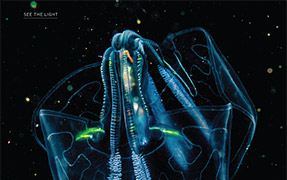A four-core fiber-optic sensor
The performance of many rigid mechanical structures is limited by deformation due to loading. Often, corrective action can be taken if the deformation is known. For example “smart structures” use actuators to compensate for unwanted shape changes.1 Fiber-optic strain gauges are well established2,3 for monitoring significant changes in the length of continuous structures due to uniform strain and thermal expansion.
Most shape variation, however, results from bending and torsion, so sensors that measure these strains are needed. Bending sensors based on two-mode fibers,4 multi-core photonic-crystal fibers,5,6 and multi-core Bragg gratings7 have been proposed. These devices can be used by adhering two fiber-optic strain sensors to either side of a flexible member3 or by embedding them both in the member.
We proposed and built a single fiber sensor with four cores that can measure multiple strains simultaneously. Here, we describe the multi-parameter relationship between the curvature, twisting angle, and ambient temperature gradient of a four-core fiber and its far-field interferogram.
The sensor is shown in Figure 1(a). The unusual structure of the single-mode, four-core fiber leads to novel waveguiding properties. In particular, an interferometric grid pattern can be formed in the far field at the output, as shown in Figure 1(b). The fiber acts as a four-beam interferometer in which changes in fiber curvature, twist, or temperature gradients in the plane containing the cores cause phase differences that shift the grid pattern.

To relate the optical birefringence and path change to these parameters, we assume that the fiber is a homogeneous, isotropic, fused-silica rod of radius r. In the case of weak curvature, that is for curvature radius R much larger than r, a simple model can be established as shown in Figure 2.

The relationship between optical phase difference and the fiber curvature R, twisting angle θ(z) and the temperature gradient is8 Here δΦm is the phase difference between core m and the fiber center, k0 = 2π /λ is the wave number for wavelength λ, n is the refractive index of the fiber core, L is the length of the four-core fiber, and d is the distance to the neighbor core. For a fused silica fiber c2 = 0.204 is a constant. A(T) is a constant, related to the gradient in temperature, T, near the fiber core. CT and αf are the temperature and thermal-expansion coefficients for the four-core fiber. θ0 is the initial orientation angle of the four-core fiber, as shown in Figure 2, and θ (Z) is the twisting angle along the fiber axis Z.
Here δΦm is the phase difference between core m and the fiber center, k0 = 2π /λ is the wave number for wavelength λ, n is the refractive index of the fiber core, L is the length of the four-core fiber, and d is the distance to the neighbor core. For a fused silica fiber c2 = 0.204 is a constant. A(T) is a constant, related to the gradient in temperature, T, near the fiber core. CT and αf are the temperature and thermal-expansion coefficients for the four-core fiber. θ0 is the initial orientation angle of the four-core fiber, as shown in Figure 2, and θ (Z) is the twisting angle along the fiber axis Z.
These four phase changes can be related to observed changes in the far-field interferometric pattern. Based on the relationship of the parameters given in Equation 1, we used a four-core fiber as a four-beam in-fiber integrated interferometer to sense curvature, twisting and temperature gradient.8 The experimental results show that the four-core fiber could be used as multi-parameter sensors and has potential applications in smart structural-condition monitoring.



